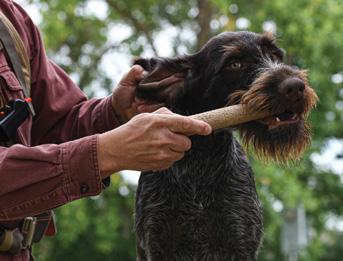
3 minute read
BULL SECRETS
Fall Tactics From The Man Who Wrote The Book On Moose Hunting
BY BOB SEXTON
Advertisement
ALONG-TIME HUNTING guide and outdoor personality, Thunder Bay, Ontario’s Jon Remus takes both science and his personal experience into account when scouting and hunting. “If you keep your mind, ears and eyes open on every trip outdoors, you’ll definitely learn something new every time,” says the host of YouTube’s Venture North Outdoors Show. Recently, the 58-year-old published the book Hunting Woodland Moose: Canadian Guides Share Their Secret Tips, a compilation of top moose-hunting tactics. We asked him to share his own top secrets for hunting big fall bulls.
SCOUTING One of the keys to moose-hunting success is year-round scouting, says Remus. “I love the old football coach saying that luck is where preparation meets opportunity,” he says. “Is it luck that you’re in the right spot at the right time because you did the right scouting and found the most active moose track? No.” Remus recommends using Google Earth to study the area you’re planning to hunt, and casting a wide net to get intel from various sources. “All summer long, ask fishing outfitters, road crews, fishermen and pilots where they’ve seen cows feeding,” he says. “Cows bring the earliest, prime bulls.”
HABITAT According to Remus, the best spots to hunt prime bulls are back bays, in particular where they empty into creeks lined with golden grass as they flow into mixed hardwood forests. Areas recovering from wildfires are also very productive. “If you want some of the most fantastic moose hunting ever, go to a seven-year-old forest fire area,” he says, adding that such regions are productive because of new tree growth, especially poplar. “When the trees reach 12 to 14 feet high, they’re still only three inches in diameter. I call them jail bar poplar because they look like jail bars. Still, they provide full cover for the moose, and every one of those trees is a food source.”
CALLING The biggest mistake hunters make is to not impart a sense of emotion in their calls, Remus says. “They listen to an instructor or tape or read about sounding it out, but the emotional part of it is the wavering, the change in how much air you push out,” he says, noting many hunters achieve a certain tone, then simply hold it, leaving out the emotional wavering. “If I’m the cow and I’m exposing myself to my enemies—wolves, bears or mountain lions—I’m letting you know I’m not in heat for four months,” Remus says. “There’s an urgency to the call.” At the same time, you should start off with soft and quiet calls. “Whether it’s a dawn or dusk sequence, you don’t get louder and louder, then go home,” he says. “It’s a climax up and down over a period of time.” OC
Dog Sense
GO FETCH!
For the most part, gun dogs love retrieving because it pleases their handlers and fuels their desire to hunt. Sometimes, though, a dog will refuse to fetch due to factors such as freezing water, foul-tasting birds and fatigue. To prevent this, use the conditioned retrieve training drill to teach your dog there are consequences for non-compliance. It’s not easy, quick or fun, but the end result is a reliable retriever. Here’s how to make sure the “fetch” command consistently results in a retrieve.
The Drill
Though not essential, this drill initially works best on a training table because the raised platform simplifies the process. The primary gear includes a thick wooden dowel (about 20 centimetres long), a leash, training bumpers and, ultimately, frozen and live birds. Start by practising the “hold” and “give” commands for a few days, and praise the dog for successfully obeying. The next step involves ear pinching to get the dog to grab the training dowel (toe-hitching or stimulus from an e-collar can also work). Simply press the dog’s ear against the collar buckle, command “fetch” and the dog will sooner or later open his mouth. When that happens, pop the dowel in his mouth and immediately stop pinching the ear. Then command “hold” (with praise), before ending with the “give” command. Repeat this drill over several weeks until the retrieve conditioning is complete. Ultimately, the dog should learn to avoid an ear pinch by automatically picking up the dowel whenever he hears the “fetch” command.
THE PROGRESS
Once your dog is consistently picking up the dowel on the training table, it’s time to incorporate short and long retrieves on the ground. Toss the dowel a short distance, then command “fetch.” Keep the dog on a check cord, and if he refuses to fetch, bring him back and pinch his ear while leading him to the dowel. Once the dog is consistently returning the dowel, start using bumpers instead, followed by real birds. —LOWELL

STRAUSS










